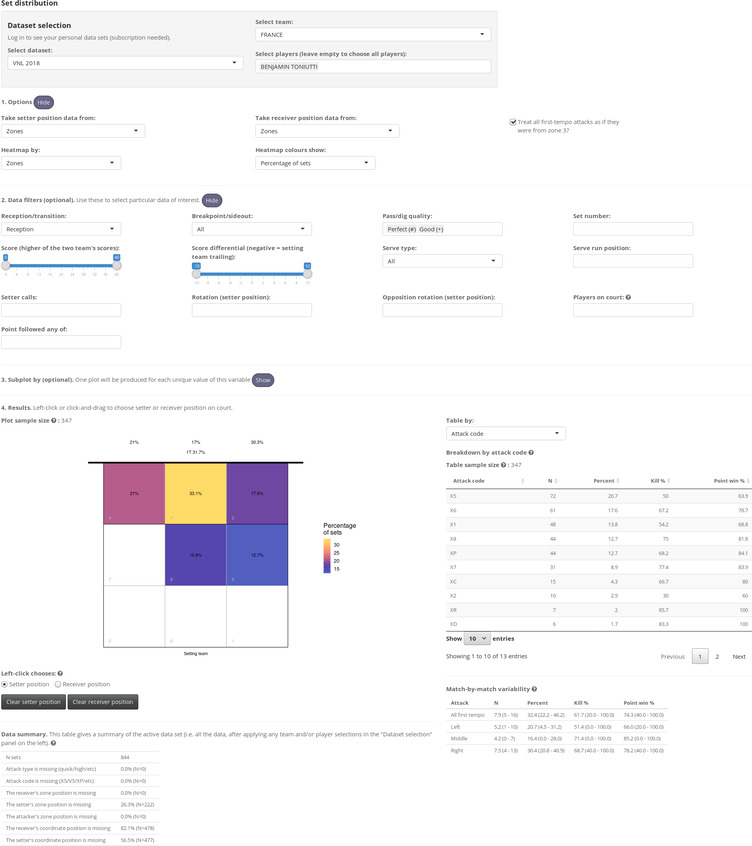Setting patterns - Benjamin Toniutti
2018-11-13
Setting patterns
Our new volleyball setting app provides an interactive framework for exploring the way a volleyball setter changes their setting patterns under different game circumstances. The data can be queried in terms of whether the team is receiving or serving, the quality of the pass, the position from which the pass or set was made, and more.
Recently, the setting patterns of French national team setter Benjamin Toniutti were examined in this video from the Volleyball Explained YouTube channel. Let’s compare Toniutti’s setting patterns reported in that video to the patterns that we see using our app.
We use data from the 2018 Men’s Volleyball Nations League tournament, in which France placed second. The data cover the complete set of 130 matches, although Toniutti only played in 14. At each step of the analysis we give the court diagram showing the percentage of sets from each zone, and report the percentage breakdown of sets that are first tempo (sets to the middle hitter, “1T”), sets to the left-side attacker (“L”), pipe sets (sets to the back-row middle attacker, “Pipe”), and sets to the right-side attacker (either front- or back-row, “R”). We also give “N”, the number of data points (number of sets) from which these percentages have been calculated. Results based on a small number of sets may be less reliable.
Note that this analysis uses only reception phase data (i.e sets on serve reception).
Baseline
First of all, let’s get Toniutti’s baseline setting percentages (that is, his overall percentage of sets in each of these categories). Using all receptions:
Filters applied:
- Phase: reception
- Setter: Toniutti
Results: (sample size N = 582)
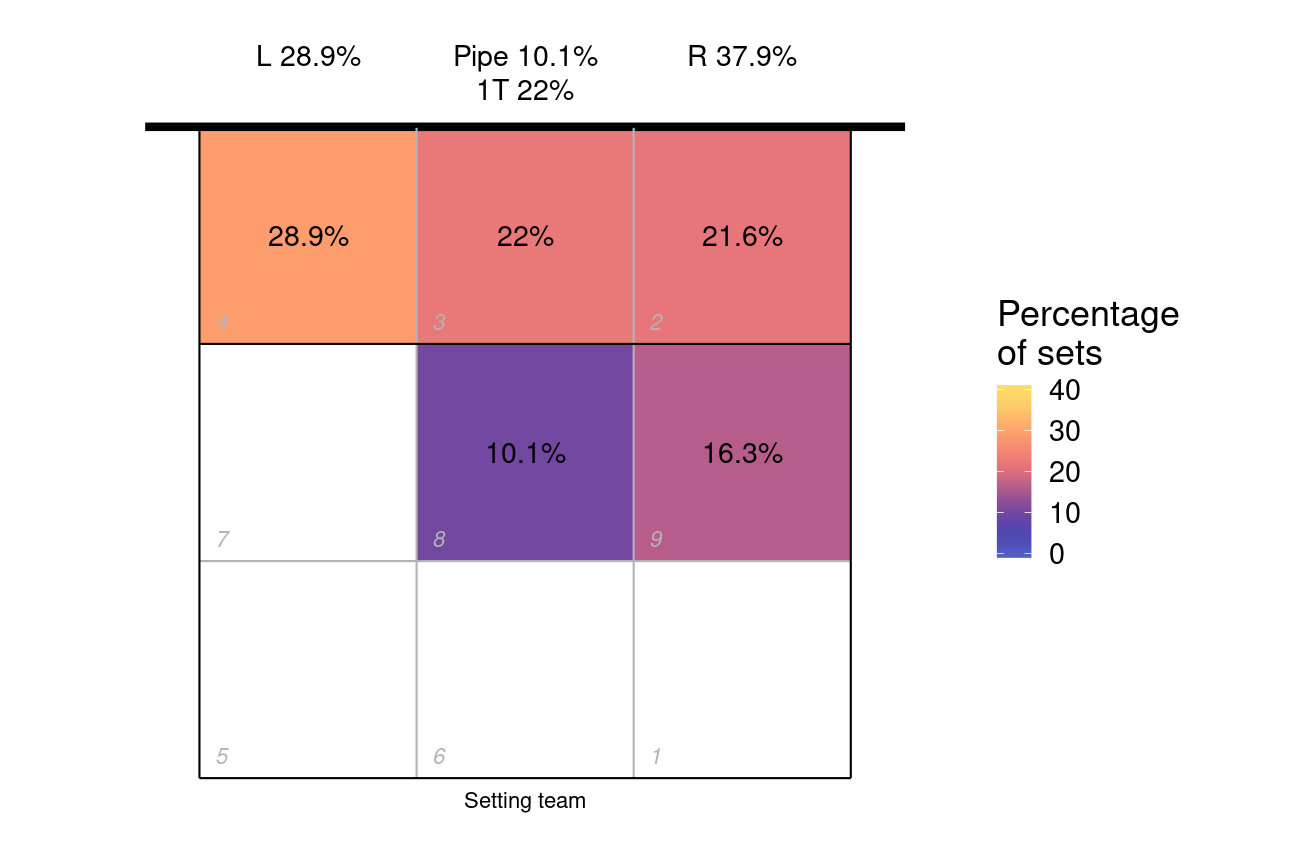
This gives us a reference against which we can see whether he uses a particular attacker more or less often under certain circumstances. The numbers below are coloured red if the value is notably lower than the corresponding baseline percentage, and blue if higher.
On good or perfect reception
Volleyball Explained says:
With good or perfect reception, and middle called close, he likes using middle or pipe.
Our data say:
Filters applied:
- Phase: reception
- Setter: Toniutti
- Pass quality: good or perfect
- Setter call: K1
Results: (sample size N = 187)
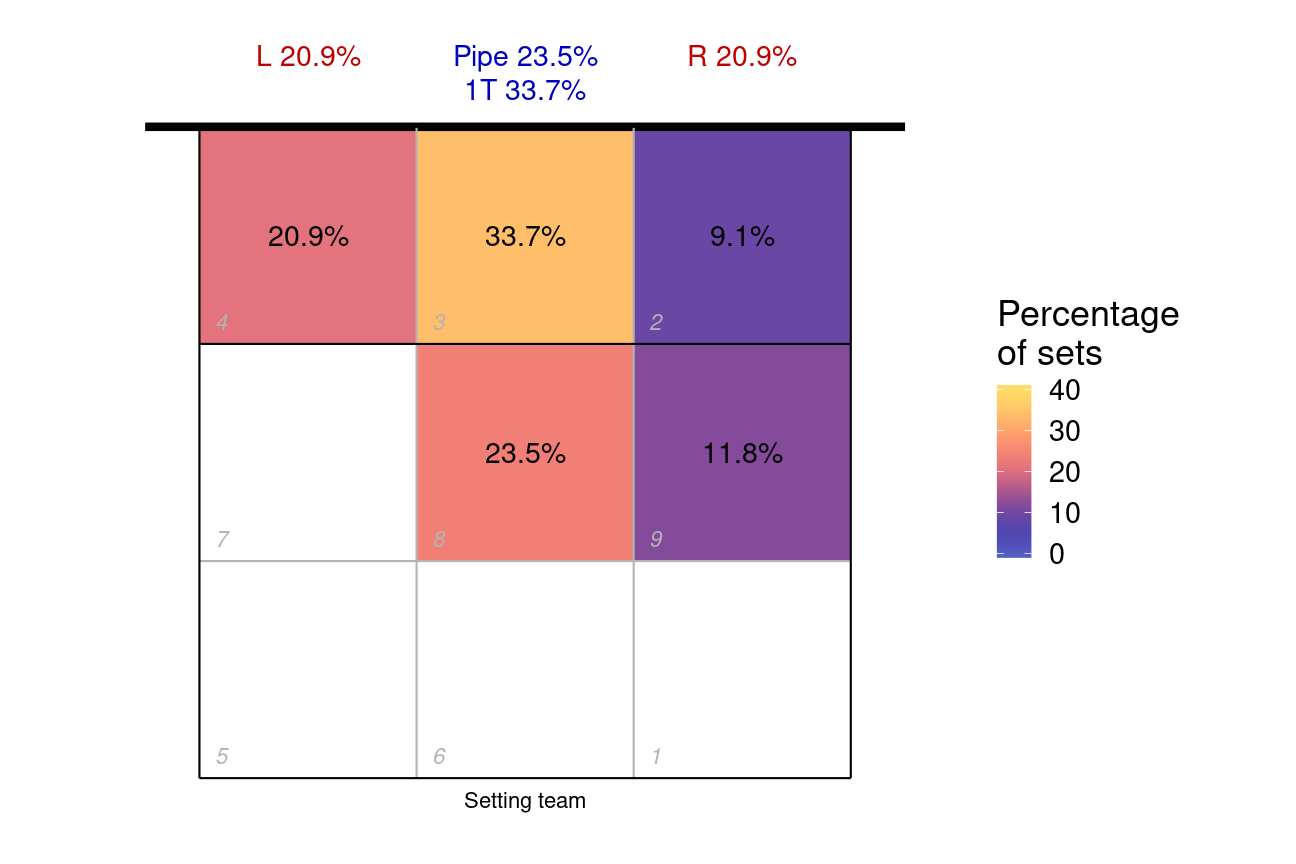
When the middle hitter was close to the setter (setter call K1), first-tempo and pipe sets were clearly being used more heavily than usual, with more than half of sets to these middle options. These increases came primarily at the expense of right-side sets. Did this pattern differ depending on how the middle hitter was running?
Volleyball Explained says:
With the middle called behind, he sets to the middle or the opposite.
and
“With middle called at a distance from the setter, he sets to the middle or the opposite.”
Our data say:
Filters applied:
- Phase: reception
- Setter: Toniutti
- Pass quality: good or perfect
- Setter call: K2
Results: (sample size N = 27)
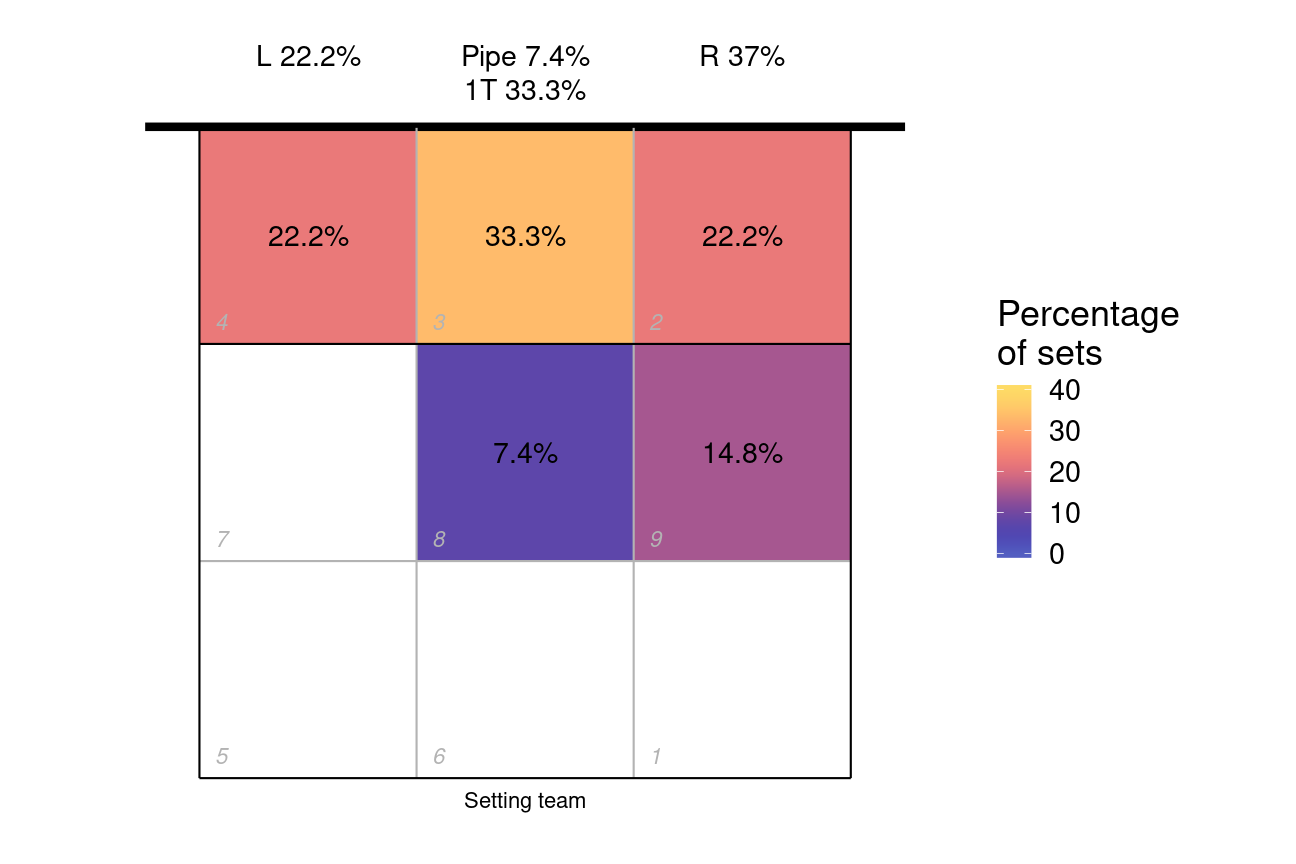
and
Filters applied:
- Phase: reception
- Setter: Toniutti
- Pass quality: good or perfect
- Setter call: K7
Results: (sample size N = 111)
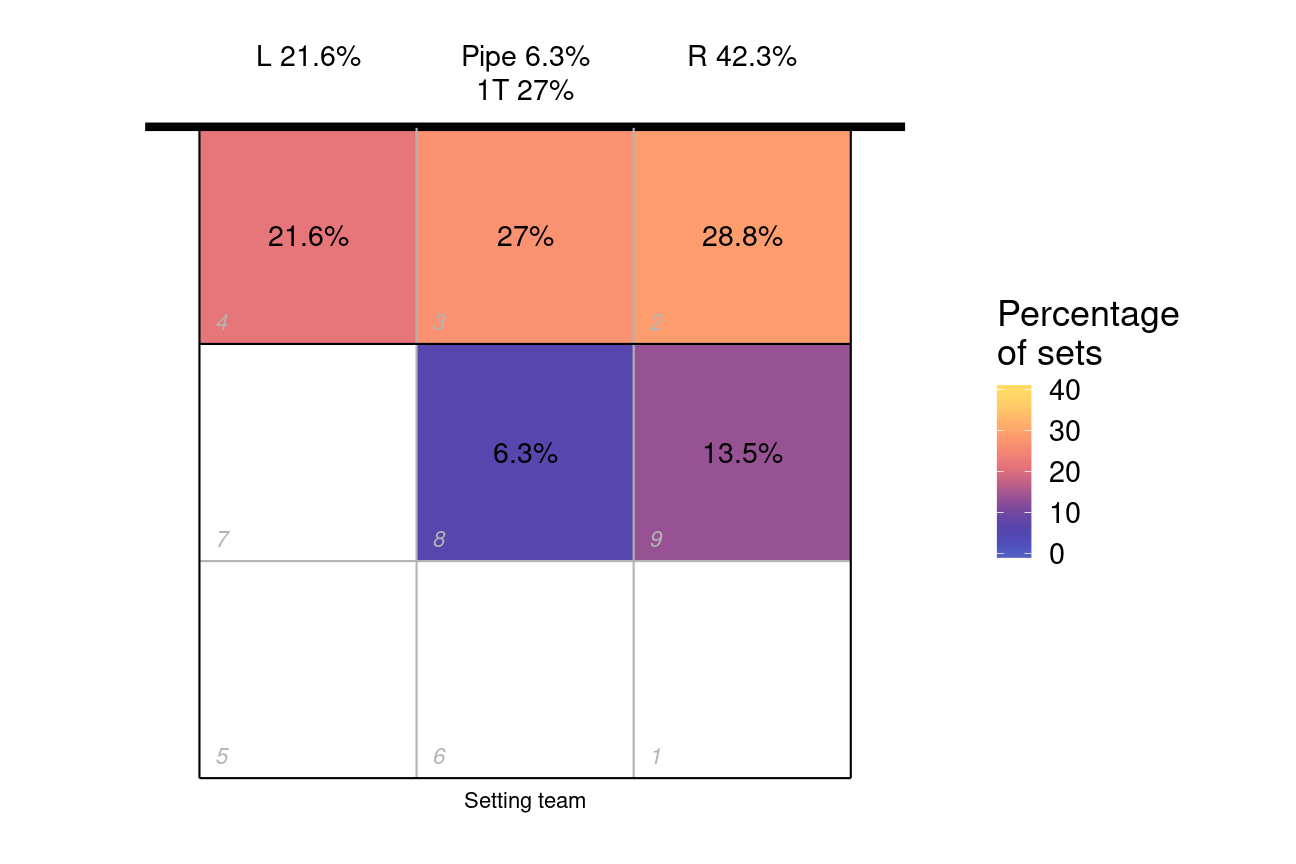
Toniutti did not often run the middle hitter behind him (setter call K2, only 27 sets in our data) but when he did, he tended to set the middle or opposite (right-side), and rarely pipes. This setting pattern was thus quite different to K1 in this regard. It was more common for him to run the middle at a distance (setter call K7, N = 111 sets in our data), with a set distribution similar to that with K2.
Setting by location and rotation
Volleyball Explained says:
With perfect reception to exactly position 3, he uses the middle a lot, especially in rotations 3 and 6.
We have two options to define “perfect reception to exactly position 3”. The setter’s location is recorded in DataVolley files in two ways: by zone (3m squares covering the court) or more precisely using coordinates (10–20 cm precision). Not all matches are scouted with coordinates, though, so relying on these often yields less data.
Our data say:
Let’s use coordinates first, and define a small region of the court representing a perfect pass to position 3. We’ll only use sets originating from there (and without imposing any additional restriction on scouted reception quality):
Filters applied:
- Phase: reception
- Setter: Toniutti
- Set from: defined area, see plot
Results: (N = 60; green shows setter position)
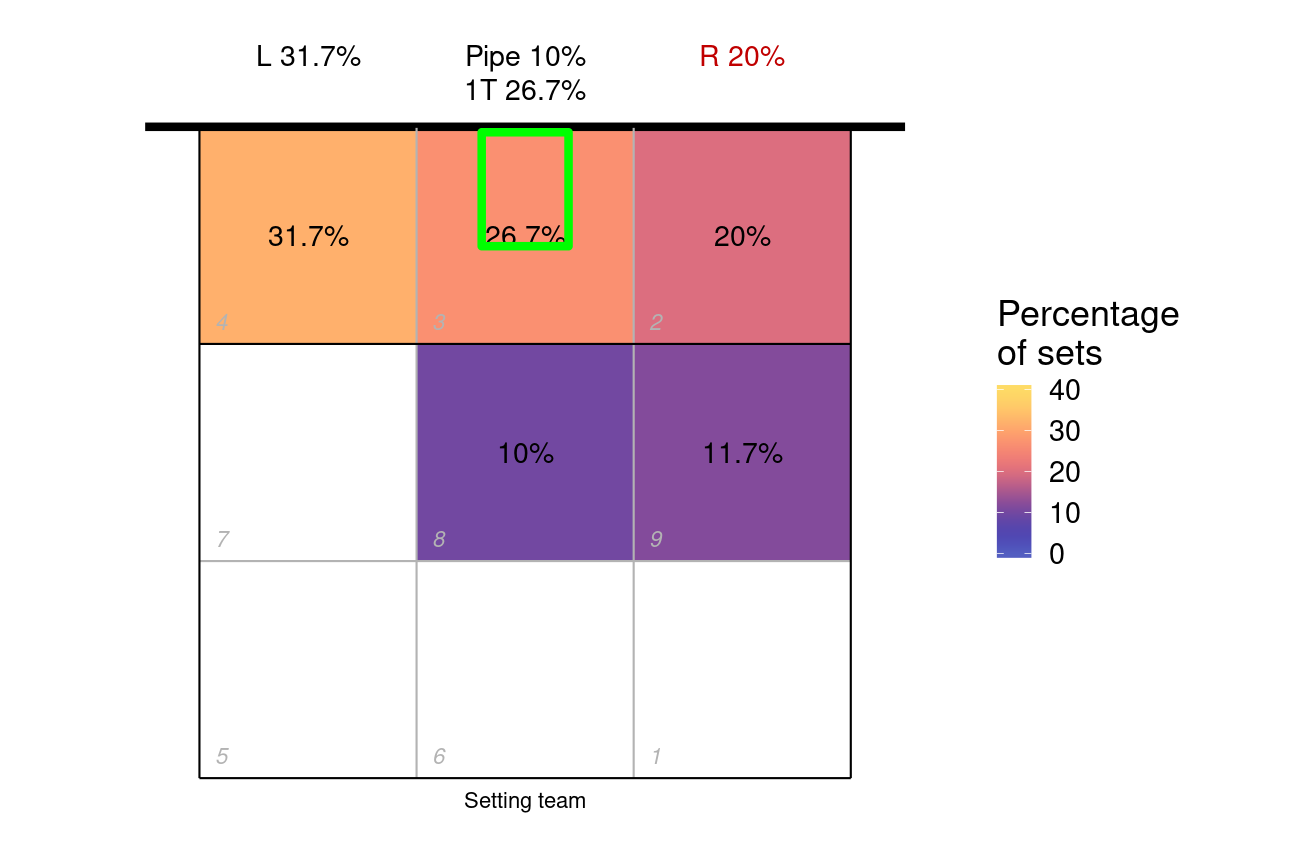
This gives us a relatively small sample size (N = 60), and we are probably missing some sets that meet our requirements (but we don’t know about them, because the setter coordinates have not been scouted in those matches).
Alternatively, we can use zone information to infer the position of the setter, and restrict ourselves to sets made from zone 3 but also place a requirement on the pass quality. Since the setter’s zone has been scouted more consistently than coordinates, this gives us a larger sample size:
Filters applied:
- Phase: reception
- Setter: Toniutti
- Pass quality: good or perfect
- Set from: zone 3
Results: (N = 211; green shows setter position)
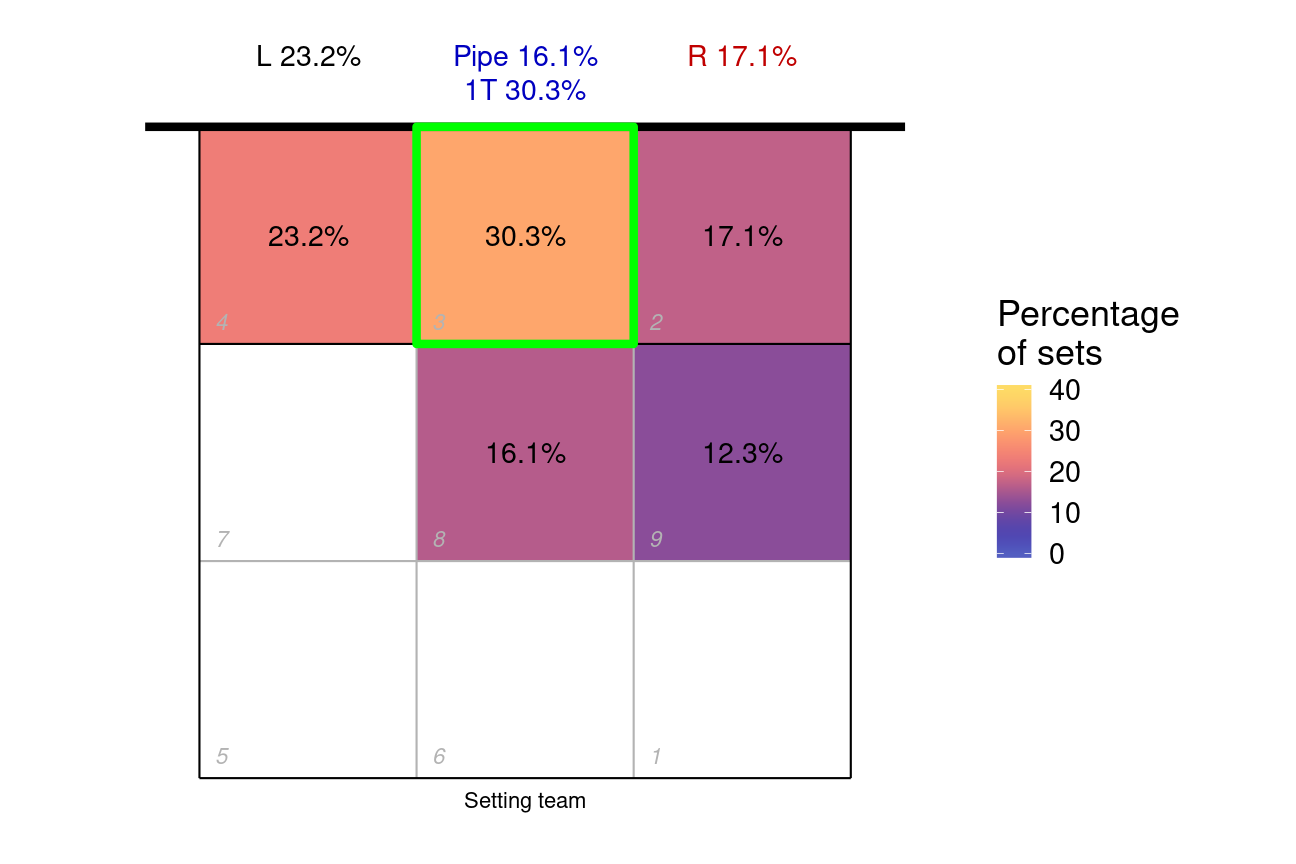
So we can see several things here:
- the second approach does yield a larger sample, but we are trading precision in setter position for sample size. Whether this represents better information for the coach probably depends on exactly what they want to know about Toniutti’s setting behaviour
- the two approaches give similar but not identical results. This demonstrates that even with a decently-sized data set (14 matches) it is not difficult to ask questions that have only a small amount of data available to answer, and thus might not give particularly reliable results. Furthermore, those results might vary depending on exactly how the data have been scouted and how they are being queried
- nevertheless, in this particular case, both sets of results suggest that Toniutti did not use his middle hitters particularly heavily in this situation (first tempo set percentage is comparable to the other perfect-reception situations described earlier).
Does this pattern vary by rotation?
Filters applied:
- Phase: reception
- Setter: Toniutti
- Pass quality: good or perfect
- Set from: zone 3
- Rotations: each individually
Results: (green shows setter position)
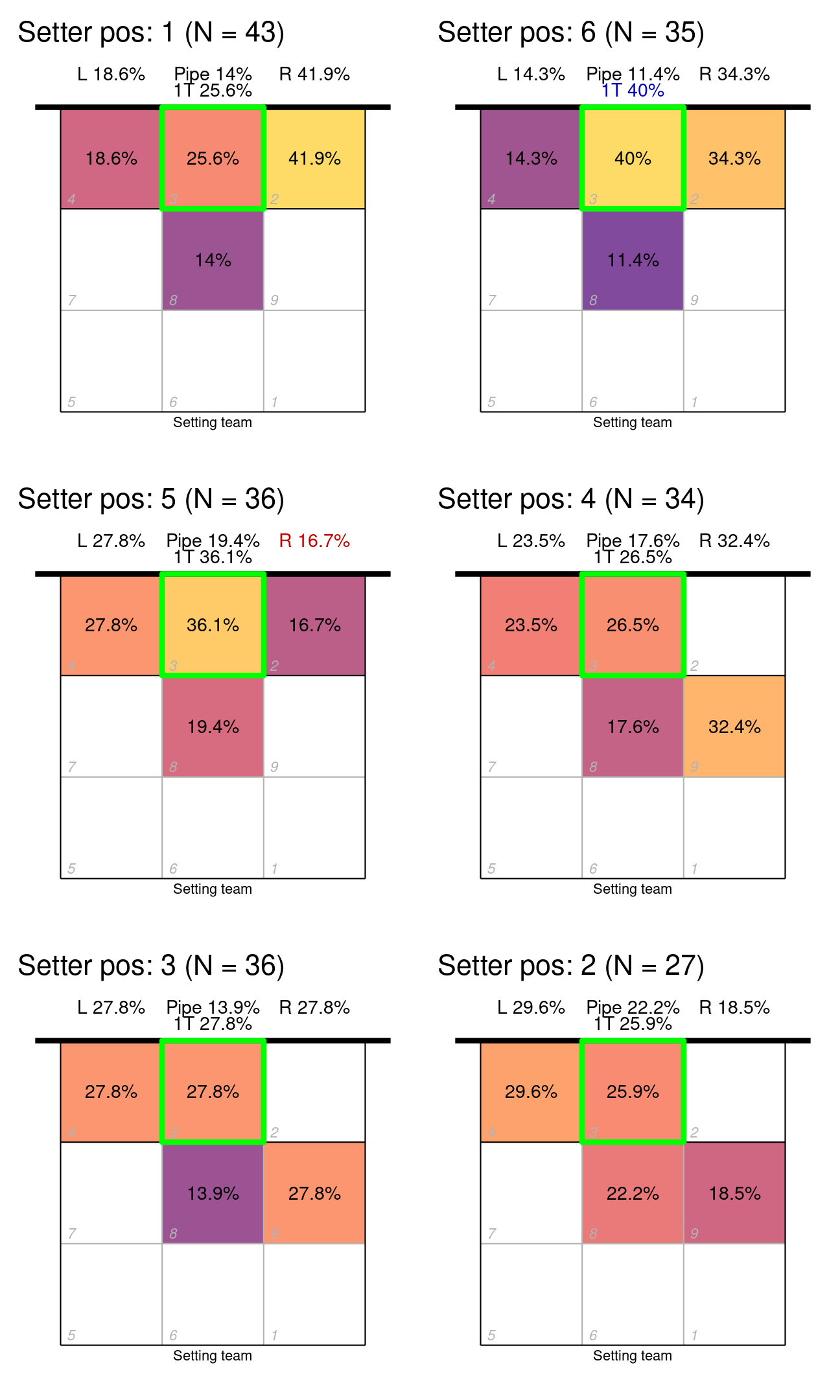
Again, our sample sizes are relatively small, but it appears that Toniutti used his middle hitters most heavily in rotations 5 and 6. This is different to the pattern reported in the video, but our small sample sizes make it difficult to be certain, and in any case our results might be specific to our data (the Nations League tournament).
On poor reception
Volleyball Explained says:
With reception on the 3m line, he uses the ends of the net and very rarely sets to the middle.
Filters applied:
- Phase: reception
- Setter: Toniutti
- Set from: defined area, see plot
Results: (sample size N = 53)
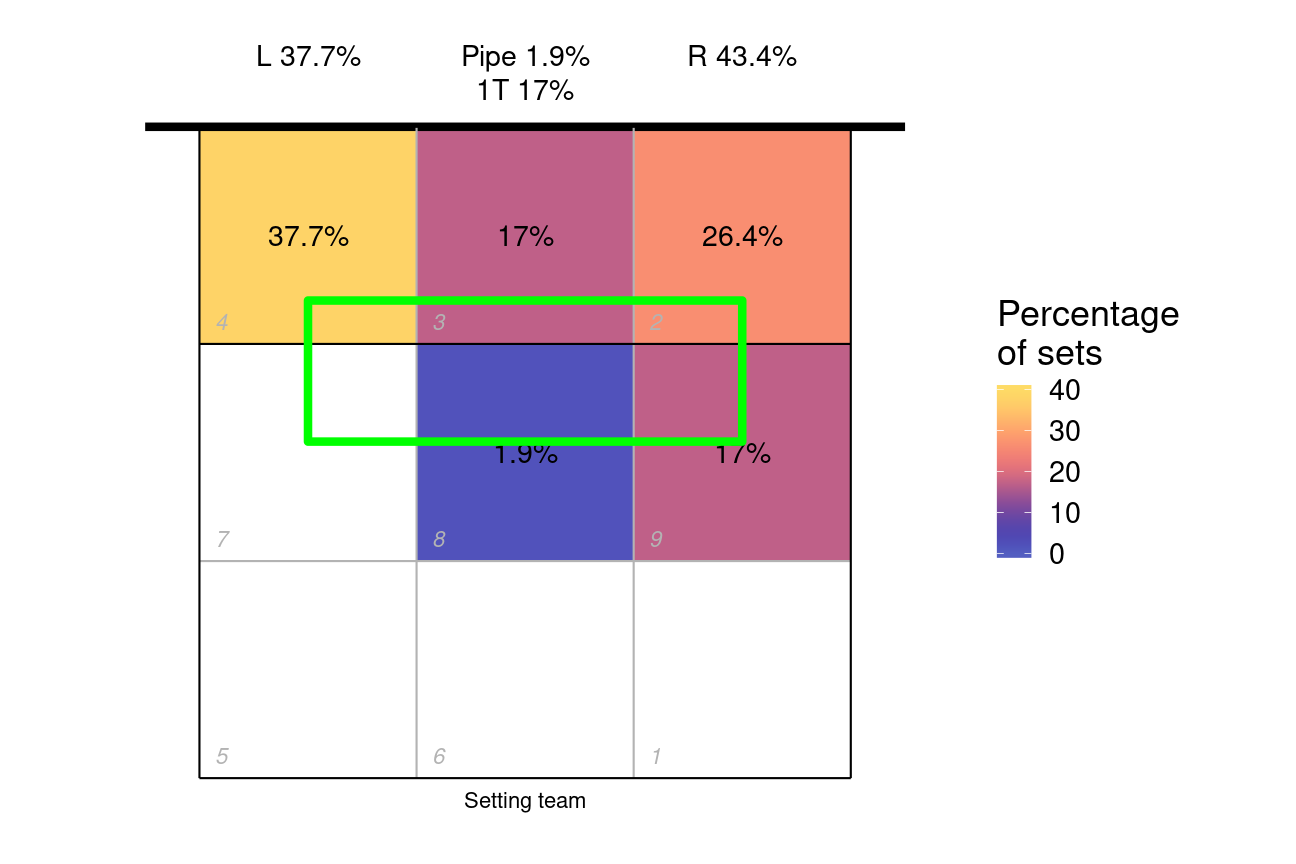
With the reception on the 3m line, Toniutti did not use first-tempo much (17% of sets) and pipes hardly ever (2%).
Surely though, you say, this is what all setters do! Let’s check the corresponding numbers using all setters from the Nations League:
Filters applied:
- Phase: reception
- All setters
- Set from: defined area, see plot
Results: (sample size N = 1543)

So indeed it seems that Toniutti’s use of first-tempo attacks was about average in this situation. Some setters — notably Bruno and William (Brazil), Jovovic (Serbia), and Kovalev (Russia) — seem to have been more willing to set their middles from here, whereas others — Lee (Korea), Baranowicz (Italy), Drzyzga (Poland) — rarely did so.
Particular players
Volleyball Explained says:
In rotations 4 and 5, on perfect and good passes, he plays a lot of pipe sets to Ngapeth.
Filters applied:
- Phase: reception
- Setter: Toniutti
- Pass quality: perfect or good
- Rotations: 4, 5
- Players must be on court: Ngapeth
Results: (sample size N = 91)
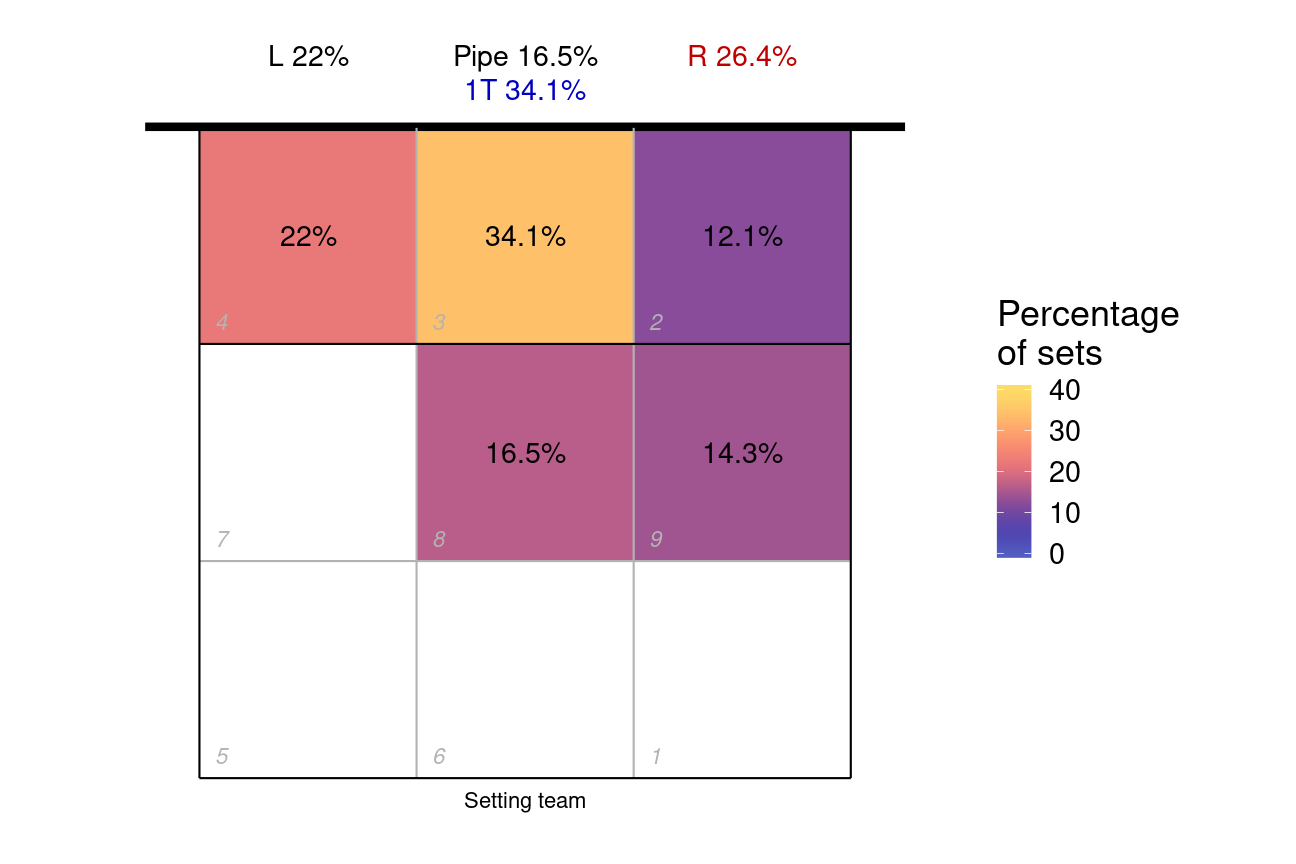
The percentage of pipe sets under these circumstances (16.5%) was higher than Toniutti’s overall average (10.1%) but was not insanely high. If we look at perfect and good passes, regardless of rotation or which hitters are on court:
Filters applied:
- Phase: reception
- Setter: Toniutti
- Pass quality: perfect or good
Results: (sample size N = 347)
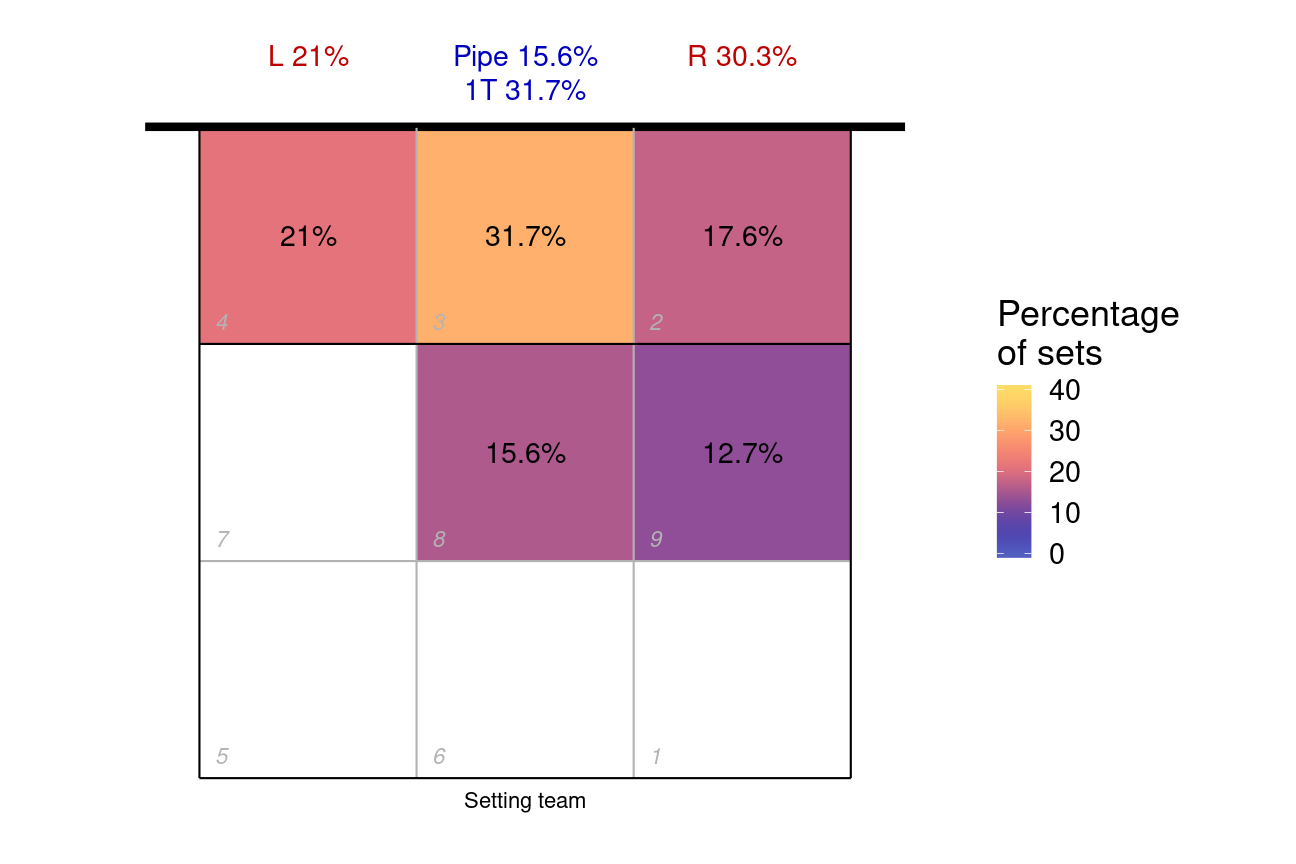
The percentage of pipe sets is basically the same as before, so it doesn’t seem that Toniutti had a particular preference for setting pipes to Ngapeth over other hitters (Tillie or Rossard), or particularly in those rotations. Note, though, that Ngapeth only played in 11 of the 14 matches that Toniutti played, which may have had some effect on this result.

